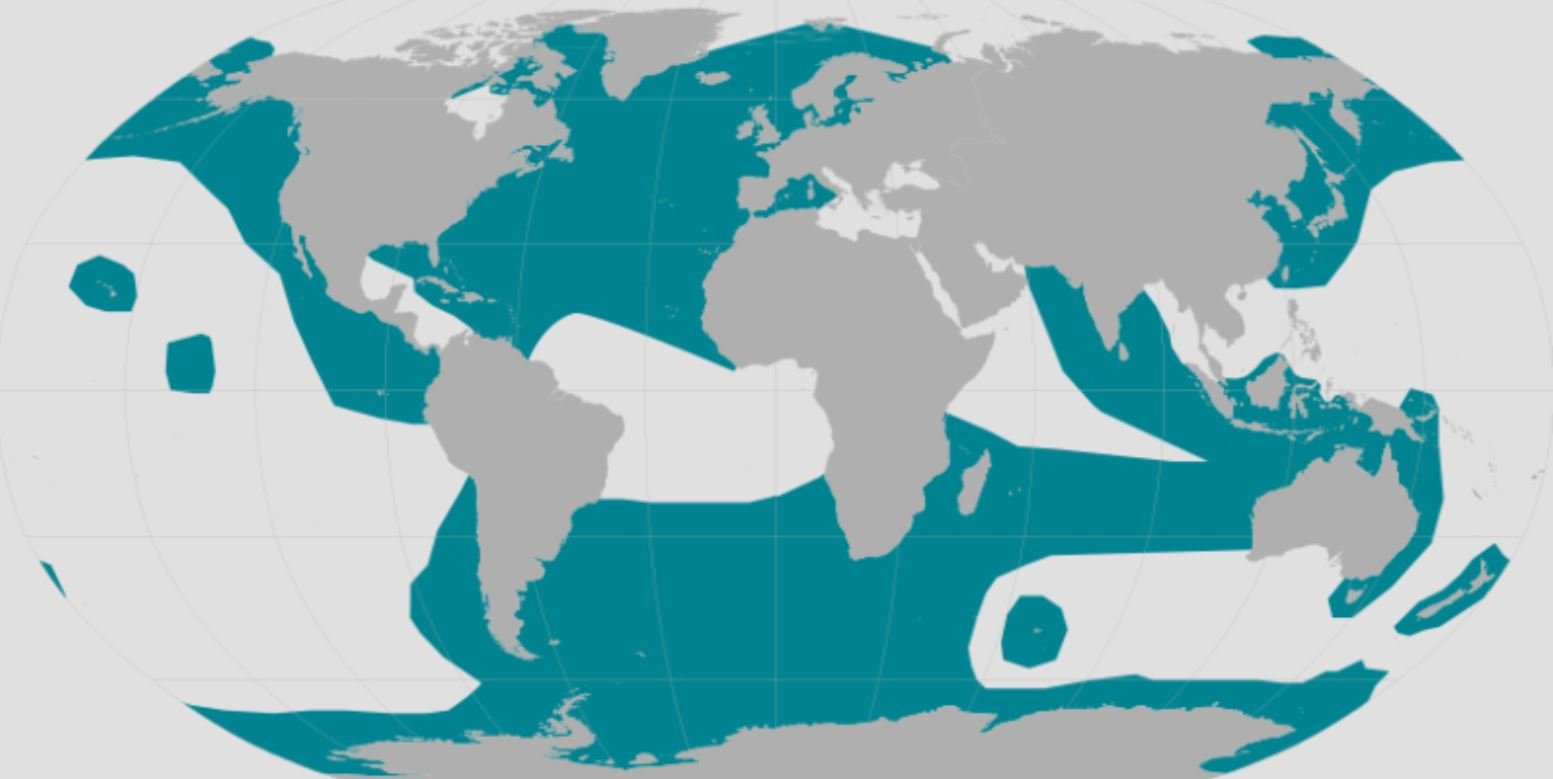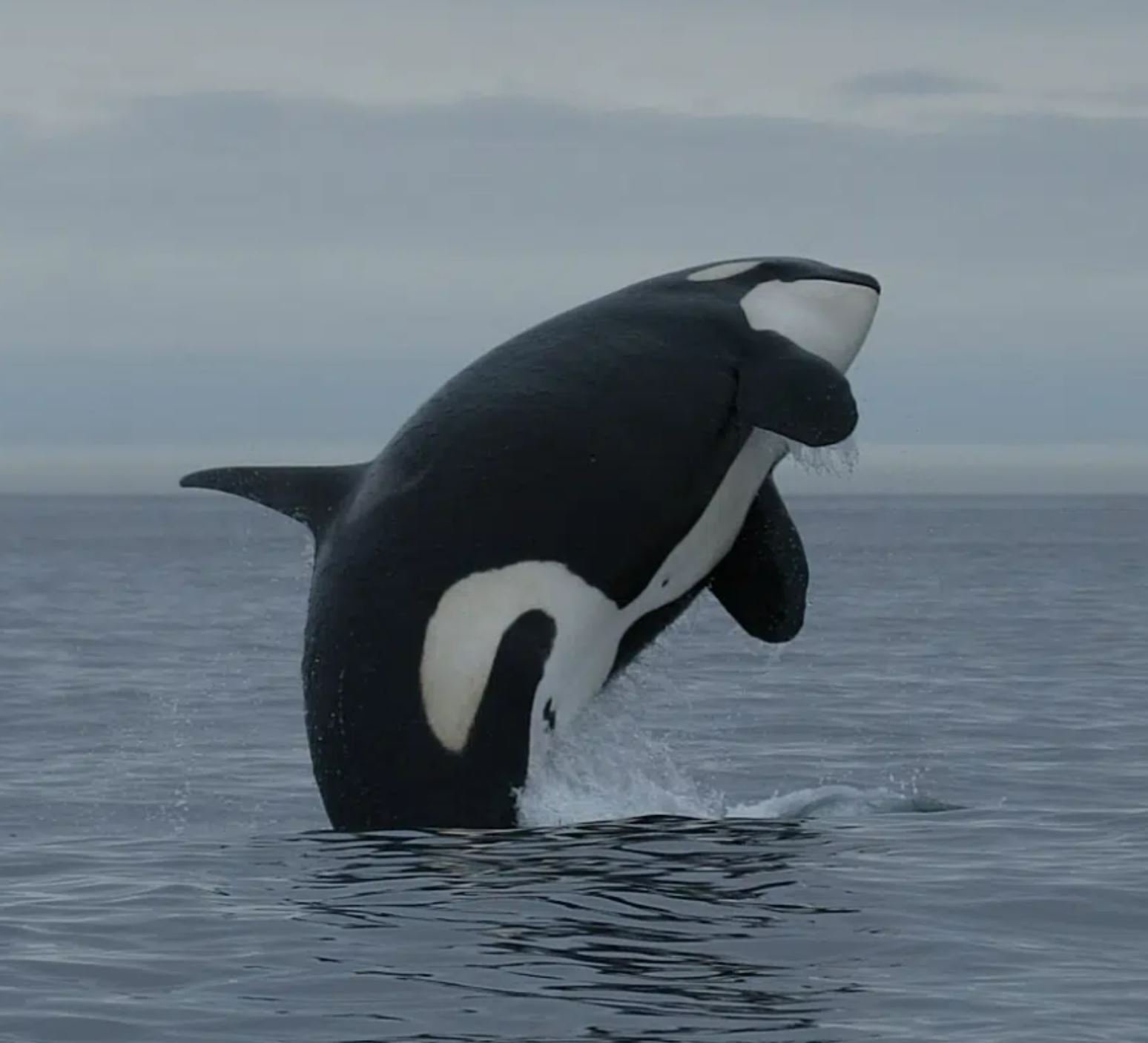Killer Whale Fact Sheet
By Rayne Billings
Killer whales, also referred to as orca whales, are best known for their striking black and white coloring and tall dorsal fins. They are found in all ocean waters of Alaska, but they are most commonly seen in Southeast Alaska, the Gulf of Alaska, and in the Chukchi and Beaufort Seas. Unlike other species of whales, killer whales are not migratory and can be seen year-round in waters surrounding the state.
Killer whales are medium-sized cetaceans that reach about 30 feet in length and 10 tons in weight. They have large dorsal fins that can reach up to 6 feet in height. Orcas live in very stable and tight-knit family groups known as “pods.” They can also be sorted into different populations (also known as “ecotypes”) based on differences in diet, pod structure, and culture. There are three populations that can be found in Alaska: Resident, Transient, and Offshore.
DID YOU KNOW…
Killer whales are one of the ocean’s top predators. Their only threat is humans.
Some populations of killer whales have even been recorded eating great white sharks!
Orcas rely on echolocation to find prey.
Female orcas have long lifespans, sometimes up to 80 years long!
Females produce a calf every 4-6 years. Their gestation period is 15-18 months long.
Killer whales are highly intelligent and are one of the few species who are able to recognize themselves in a mirror.
Photo courtesy of Encyclopedia Britannica
SCIENTIFIC AND COMMON NAMES
Orcinus orca; killer whale; orca whale, kéet (Tlingit), sg̱áan (Haida)
GENERAL DESCRIPTION
The killer whale is a toothed whale most known for its black and white coloring. They have tall dorsal fins reaching up to 6 feet in height and large, rounded pectoral flippers. Killer whales have large, white eyespots and white underbellies. While the exact reasoning for this coloration is unknown, it is speculated that it serves as a form of camouflage; when viewed from above, they appear dark like the water, but when viewed from below, their bodies appear more light in color like the sea’s bright surface, making them harder to detect. The large white areas also break up their body and make them appear smaller to potential prey.
Because killer whales are toothed whales, not baleen whales, they do not feed in the same way as humpback whales or other baleen whales. Instead of filter feeding, killer whales hunt their prey similar to terrestrial carnivores. They will often hunt in packs, and many killer whales will share their prey among their entire pod.
Orca whales have a large gray patch behind their dorsal fins. This marking is known as the “saddlepatch”, and it can be used to identify individual whales. It is similar to a human fingerprint; each saddlepatch is unique to that whale. Sometimes, the saddlepatch can even show what population that killer whale is from.
Check out this video of orcas hunting for fish…
RANGE
Map courtesy of NOAA Fisheries
Killer whales can be found in all maritime waters of Alaska. They are not migratory and do not tend to follow strict seasonal patterns, so they can be spotted at any time of year. They are most commonly seen near the continental shelf, from Southeast Alaska to the Aleutians. They are also found regularly in the Chukchi and Beaufort Seas.
Killer whales are one of the most wide-ranging mammals on the planet. They can be found in every ocean, but live in higher concentrations near the poles, specifically in cold, temperate waters.
THREATS/CONCERNS
One of the major threats to killer whales is pollution, specifically “bioaccumulative pollutants.” Bioaccumulative pollutants, such as pesticides or other chemicals, are pollutants that are acquired through an animal’s diet or environment. These pollutants get more concentrated in animals as they go up the food chain, and they can eventually accumulate in toxic levels for animals at the top (predators). This can cause issues with fertility and immunity, and milk produced in mammals can contain these pollutants. Many orca populations have extremely high concentrations of these pollutants, some up to 100x the safe level. These pollutants have been referred to as a “killer whale apocalypse” with up to half of all killer whale populations at risk of extinction due to these effects.
Another threat is noise pollution. Because killer whales rely on echolocation to hunt, high noise levels can interfere and leave them unable to find food. This is especially harmful to killer whales who can be found in urbanized areas, such as the populations that live near Washington and British Columbia.
Historically, killer whales were often shot on sight as they had a reputation for being extremely dangerous, similar to sharks. Some killer whales were hunted for meat or oil, however, not to the same extent as many other whale species. Worldwide, many killer whales have also been captured for display in marine parks and aquariums. While this is no longer legal in the United States, it still occurs in some countries.
Photo courtesy of Whale and Dolphin Conservation
LIFE HISTORY
Killer whales live in pods. The pods are matrilineal, meaning that it is typically made up of a mother and her offspring. In some populations, this will also include the extended family, meaning that pods will average around 40 animals. Females lead these family groups.
There are three ecotypes of killer whales that live in Alaska. These are known as the Residents, Transients, and Offshores. Offshore killer whales are rarely sighted, as they tend to live far off the continental shelf. However, residents and transients are spotted regularly. All three populations have entirely different diets, cultures, and even speak different languages! Different ecotypes of whales do not tend to socialize and rather avoid one another.
One of the easiest ways to tell the different populations apart is through their diet. Killer whales are dietary specialists, meaning that, for the most part, they will only eat one specific type of food. Resident killer whales only eat fish, while transient killer whales only eat marine mammals. It is estimated that resident and transient killer whales have not interbred in almost 700,000 years. There are believed to be about 1200 resident killer whales that live in Alaskan waters.
Killer whales have life spans and life histories similar to humans. Males tend to live until they are in their mid-30’s, but they can live for longer. Females can live to be up to 80 years old, but they tend to live until their mid-50’s on average. On average, most killer whales reach sexual maturity at around 15 years of age, and they go through menopause at around age 40. Killer whales are one of only three species who go through menopause (also including humans and short-finned pilot whales). Menopause is believed to occur due to something known as the “granny hypothesis”: older females are important in killer whale societies because they lead the pod and, due to their long life spans, know vital information about where to find prey sources at different times of the year. It is believed that these older females stop reproducing in order to conserve resources for the entirety of the pod and focus their attention on helping raise already-existing calves. Most female killer whales tend to have a single calf every 4-6 years, with a gestation period of 15-18 months. Because of their matrilineal pod structure, most calves will stay with their mother for their entire life.
Watch this video to learn more about orcas and their matriarchal systems…
DIET
Killer whale diets are entirely dependent upon the population that they come from. Each population of killer whale has a different diet. It is thought that this is a form of resource specialization, which allows different killer whale populations to live in the same region without having to compete over food.
Killer whales have many techniques that they will use to catch their prey. They will often work together and coordinate hunting tactics. For example, killer whales in Antarctica will work together and form waves to push seals off of ice flows and into the water, where they can easily be hunted.
Orcas use echolocation, a form of identifying the location of objects through sound waves, in order to find and hunt their prey. They have a large organ in their forehead known as a melon. The melon is capable of producing high-frequency sound waves that are sent out into the whale’s environment. If these sound waves hit an object, the whale will hear an echo. Killer whales can pick up on very specific information through echolocation. For example, resident, fish-eating orcas are able to tell different species of salmon apart from one another by listening to the ways their echolocation bounces off the fish’s swim bladder. They can even detect the difference between a golf ball and a ping-pong ball!
Photo courtesy of NOAA Fisheries
Watch killer whales hunt seals among sea ice…
CULTURAL SIGNIFICANCE
Killer whales are featured prominently in many Northwest Coast indigenous cultures. The Natsilane story depicts the creation of Blackfish, the killer whale, one of the most important creatures in Haida and Tlingit culture. Killer whales are revered and seen as equal to humans in Haida and Tlingit culture.
Killer Whale COLORING SHEET
We hope you learned something new about killer whales! Check out our Facebook, Instagram, and Twitter to learn more about Alaska’s wildlife, and subscribe to our free newsletter to get updates from the Alaska Wildlife Alliance! If you want to support wildlife conservation in Alaska, you can become a member for $35 dollars a year!
_____________________________________________________________________________
Information obtained from: Encyclopedia Britannica, Whales and Dolphins, Alaska Department of Fish & Game, NOAA Fisheries, Center for Whale Research, The Guardian, Wikipedia, Alaska SeaLife Center, and The Atlantic.







